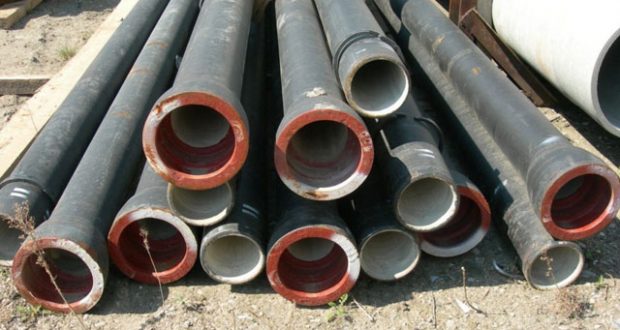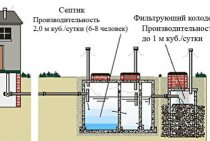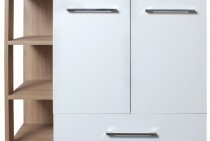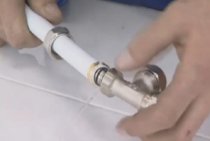Cast iron sewer dimensions
When arranging a sewage disposal system, cast-iron sewer pipes are often used. With their help, they also create an external water main. Despite the fact that the domestic market is increasingly conquered by plastic pipes, cast iron products are still in demand.
Characteristics of cast iron sewer pipes
By itself, such a material as gray cast iron is fragile: pipes are produced by centrifugal casting. During installation, cast iron products are not recommended to be dropped and subjected to shock loads.
To protect against corrosion, and therefore extend the life of cast iron pipes, they are coated inside and out with a special composition - petroleum bitumen. Thanks to this coating, the inner surface of the products becomes smooth and thereby reduces the coefficient of friction of the liquid medium against the walls.
As practice has proven, the resistance to corrosion processes of cast iron pipes is much higher than that of other metal products.
Among the large assortment of products from manufacturing companies, you can find cast-iron socket sewer pipes (they are shown in the photo).
For 150 mm pipes, this parameter is 7 millimeters (read: “Sewer pipe socket - types and methods of joining“).
The elements of the wastewater disposal system are connected using fittings. The sizes of cast-iron sewer pipes are different. According to GOST, the size range of these products depends on the diameter of the products (read: “The diameter of the sewer pipe for a private house - which ones are there, which one to choose“).
So, if the diameter of the cast-iron sewer pipe is 100 millimeters, it is used in the arrangement of the system for draining wastewater from the toilet. With the help of elements with this parameter half as large, a sewer outlet from sinks, sinks and washbasins is mounted.
https://youtube.com/watch?v=DW6BmwvxHNw
The service life of sewer pipes made of cast iron (according to the manufacturer's warranty) reaches 80 years.
Of the disadvantages of cast iron products, it should be noted:
- the presence of a rough inner surface in the pipe, which leads to the formation of deposits from solid fractions present in the drained waste water due to an increase in resistance;
- high consumption of material;
- significant weight of the cast-iron sewer pipe, since it makes it difficult to carry out installation work;
- the high cost of cast iron products - the production of this material is very expensive.
Features of connecting cast iron pipes for sewerage
The elements of the network are connected during the construction of the sewer system by using sockets located at one end of the products.
Installation of cast iron sewer pipes is carried out in several stages:
- First, a part of the product without a socket is inserted into the socket of an already installed element.
- As previously mentioned, there is a gap between the edges of the socket from the inside and part of the pipe placed in it. It should be sealed with tow. They do this by hammering the tow wound on the pipe into the bell with the help of a special wooden spatula. For this purpose, it is hit with a hammer. It is necessary to carefully monitor that in the process of caulking the tow does not get into the pipe, otherwise the sewage system will become clogged.
- When the bell is about 2/3 filled with sealant, the work on caulking is stopped. The remaining third is filled with tow that has not been treated with impregnation, since otherwise the quality of adhesion to cement deteriorates significantly.
The socket is filled with cement mortar (a mixture of water and cement grade M300 or M400 in a ratio of 1: 9). It is tamped down and a rag moistened with water is placed on top of it.
When installing the sewerage of cast-iron pipes, it is necessary to seal the joints between the elements of the system. The cement mortar can be replaced with a silicone sealant or an asbestos-cement mixture consisting of one part of asbestos-cement fiber and two parts of cement.It is diluted with water to a consistency resembling a thick dough.
Pig-iron sewer pipe GOST 6942-98
- Climatic modification - UHL4 according to GOST 15150
- Material - gray cast iron with lamellar graphite according to GOST 1412-85
- Black colour
- Installation of cast-iron pipes and fittings for them must be carried out in accordance with SNiP (building codes and regulations). Pipes and pipeline parts are interconnected by pouring heated sulfur or by caulking the sockets with a tarred strand and cement, as well as using rubber sealing cuffs
- Certificate / passport (on request)
- Price per meter / price list ( on request )
Specifications and dimensions
| Name | Building lengthL (m) | a (mm) | b(mm) | D1 (mm) | D2 (mm) | Dn (mm) | S(mm) | Outer Diameter (mm) | Weight, kg) | Cost, rub.) |
| Pig-iron sewer pipeChK, DN 50, 2 m GOST 6942-98 | 2 meters | 13 | 60 | 65 | 74 | 50 | 4 | 58 | 11 | Price on request |
| Pig-iron sewer pipeChK, DN 100, 1 m GOST 6942-98 | 1 meter | 14 | 70 | 118 | 125 | 100 | 4.5 | 109 | 14 | Price on request |
| Pig-iron sewer pipeChK, DN 100, 2 m GOST 6942-98 | 2 meters | 14 | 70 | 118 | 125 | 100 | 4.5 | 109 | 26 | Price on request |
| Pig-iron sewer pipeChK, DN 150, 2 m GOST 6942-98 | 2 meters | 15 | 75 | 168 | 178 | 150 | 5 | 160 | 40 | Price on request |
GOST 6942-98 cast-iron sewer pipes and fittings for them. specifications

1 area of use
This standard applies to cast iron sewer pipes and fittings for them intended for internal sewerage systems of buildings.
Mandatory requirements for product quality are set out in: 5.1; 5.2.2 - 5.2.4; 5.2.7; 5.2.8; 5.3.1; 5.3.2.
Normative references
This standard uses references to the following standards:
- GOST 164-90 Height gauges. Specifications
- GOST 166-89 Calipers. Specifications
- GOST 1412-85 Cast iron with lamellar graphite for castings. Stamps
- GOST 9812-74 Oil insulating bitumen. Specifications
- GOST 11506-73 Petroleum bitumen. Ring and ball softening point method
- GOST 15150-69 Machinery, instruments and other technical products. Versions for different climatic regions. Categories, conditions of operation, storage and transportation in terms of the impact of climatic environmental factors
- GOST 18510-87 Writing paper. Specifications
- GOST 26358-84 Cast iron castings. General specifications
- GOST 26598-85 Containers and packaging facilities in construction. General specifications
- GOST 26645-85 Castings from metals and alloys. Dimensional tolerances, weights and machining allowances.
3 Assortment
Table 1
| Name | Nominal passages, mm | Symbol | |
| Do | du | graphic | literal |
| Pipes | 50
100 150 |
—
— — |
SP-Dy-L |
| Branch pipes | 50
100 150 |
—
— — |
П-Ду -L |
| Compensation pipes | 100
150 |
—
— |
PC-Dy |
| Adapter pipes | 50/100
100/150 |
—
— |
PP-D1 x Dy |
| knees | 50
100 150 |
—
— — |
K-Du |
| Knees low | 100 | — | KN-100 |
| Elbows 110° and 120° | 50
100 |
—
— |
About 110°-Dy or
About 120°-Dy |
| Elbows 135° | 50
100 150 |
—
— — |
About 135°-Dy |
| Elbows 150° | 50
100 100D 150 |
—
— — — |
About 150°-Dy |
| Branches-tees instrument | 100 | 50 | OTPR-100x50 or LOTPr-100x50 |
| Indentation | 50
100 150 |
—
— — |
OTS-Du |
| Straight tees | 50
100 100 100 100 150 150 150 |
50
50 100 100K 100D 50 100 150 |
TP-Dy x dy |
| Equal expansion tees | 100
150 |
50
50 |
TPK-Dy x dy |
| Straight low tees | 100 | 100 | TN-100 x 100 |
| Straight reducing tees | 100/50 | 100 | TPR-100/50x100 |
| Straight reducing tees low | 100/50 |



